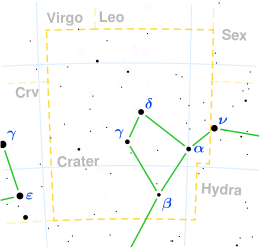Alpha Crateris

| |
| Observation data Epoch J2000 Equinox J2000 | |
|---|---|
| Constellation | Crater |
| Right ascension | 10h 59m 46.46486s[1] |
| Declination | −18° 17′ 55.6172″[1] |
| Apparent magnitude (V) | 4.07[2] |
| Characteristics | |
| Spectral type | K1 III[3] |
| Astrometry | |
| Radial velocity (Rv) | 47.54 ± 0.16[4] km/s |
| Proper motion (μ) | RA: −462.26 ± 0.24[1] mas/yr Dec.: 129.49 ± 0.26[1] mas/yr |
| Parallax (π) | 20.49 ± 0.27[1] mas |
| Distance | 159 ± 2 ly (48.8 ± 0.6 pc) |
| Absolute magnitude (MV) | +0.44[5] |
| Details | |
| Mass | 1.81[6] M☉ |
| Radius | 12.32[6] R☉ |
| Luminosity | 66.0[6] L☉ |
| Surface gravity (log g) | 2.53[6] cgs |
| Temperature | 4.691[6] K |
| Metallicity [Fe/H] | +0.01[6] dex |
| Age | 2.06[6] Gyr |
| Other designations | |
| Database references | |
| SIMBAD | data |
Alpha Crateris (α Crateris, abbreviated Alpha Crt, α Crt), also named Alkes,[7] is a star in the constellation of Crater.
Nomenclature
α Crateris (Latinised to Alpha Crateris) is the star's Bayer designation.
It bore the traditional name Alkes, from the Arabic الكاس alkās or الكأس alka's "the cup". In the catalogue of stars in the Calendarium of Al Achsasi al Mouakket, this star was designated Aoul al Batjna (أول ألبجن awwil albajna), which was translated into Latin as Prima Crateris, meaning "the first cup".[8] In 2016, the International Astronomical Union organized a Working Group on Star Names (WGSN)[9] to catalogue and standardize proper names for stars. The WGSN approved the name Alkes for this star on 12 September 2016 and it is now so entered in the IAU Catalog of Star Names.[7]
In Chinese, 翼宿 (Yì Sù), meaning Wings (asterism), refers to an asterism consisting of Alpha Crateris, Gamma Crateris, Zeta Crateris, Lambda Crateris, Nu Hydrae, Eta Crateris, Delta Crateris, Iota Crateris, Kappa Crateris, Epsilon Crateris, HD 95808, HD 93833, Theta Crateris, HD 102574, HD 100219, Beta Crateris, HD 99922, HD 100307, HD 96819, Chi1 Hydrae, HD 102620 and HD 103462.[10] Consequently, Alpha Crateris itself is known as 翼宿一 (Yì Sù yī, English: the First Star of Wings.).[11]
Namesake
USS Alkes (AK-110) was a United States Navy Crater class cargo ship named after the star.
Properties
Alpha Crateris is an orange giant of spectral type K1III. It has an apparent magnitude of 4.07, and is 174 light years from Earth. It is thought to be a horizontal branch star, meaning it is fusing helium in its core after a helium flash. Cool horizontal branch stars are often called red clump giants as they form a noticeable grouping near the hot edge of the red giant branch in the H-R diagrams of clusters with near-solar metallicity. On this basis it is calculated to have a mass of 1.81 M☉, a luminosity of 77 L☉, and an age around two billion years. Its surface temperature is 4645 K. Or it might be a red giant branch star, still fusing hydrogen in a shell around an insert helium core, in which case it would be slightly less massive, older, cooler, larger, and more luminous.[6]
References
- 1 2 3 4 5 Van Leeuwen, F. (2007). "Validation of the new Hipparcos reduction". Astronomy and Astrophysics. 474 (2): 653. Bibcode:2007A&A...474..653V. doi:10.1051/0004-6361:20078357.
- ↑ Ducati, J. R. (2002). "VizieR Online Data Catalog: Catalogue of Stellar Photometry in Johnson's 11-color system". CDS/ADC Collection of Electronic Catalogues. 2237. Bibcode:2002yCat.2237....0D.
- ↑ Houk, N.; Smith-Moore, M. (1988). "Michigan Catalogue of Two-dimensional Spectral Types for the HD Stars. Volume 4, Declinations -26°.0 to -12°.0". Michigan Catalogue of Two-dimensional Spectral Types for the HD Stars. Volume 4. Bibcode:1988MSS...C04....0H.
- ↑ Massarotti, Alessandro; Latham, David W.; Stefanik, Robert P.; Fogel, Jeffrey (2008). "Rotational and Radial Velocities for a Sample of 761 HIPPARCOS Giants and the Role of Binarity". The Astronomical Journal. 135: 209. Bibcode:2008AJ....135..209M. doi:10.1088/0004-6256/135/1/209.
- ↑ Cardini, D. (January 2005), "Mg II chromospheric radiative loss rates in cool active and quiet stars", Astronomy and Astrophysics, 430: 303–311, Bibcode:2005A&A...430..303C, doi:10.1051/0004-6361:20041440.
- 1 2 3 4 5 6 7 8 Reffert, Sabine; Bergmann, Christoph; Quirrenbach, Andreas; Trifonov, Trifon; Künstler, Andreas (2015). "Precise radial velocities of giant stars. VII. Occurrence rate of giant extrasolar planets as a function of mass and metallicity". Astronomy & Astrophysics. 574: A116. Bibcode:2015A&A...574A.116R. doi:10.1051/0004-6361/201322360.
- 1 2 "IAU Catalog of Star Names". Retrieved 28 July 2016.
- ↑ Knobel, E. B. (June 1895). "Al Achsasi Al Mouakket, on a catalogue of stars in the Calendarium of Mohammad Al Achsasi Al Mouakket". Monthly Notices of the Royal Astronomical Society. 55 (8): 429. Bibcode:1895MNRAS..55..429K. doi:10.1093/mnras/55.8.429.
- ↑ IAU Working Group on Star Names (WGSN), International Astronomical Union, retrieved 22 May 2016.
- ↑ (in Chinese) 中國星座神話, written by 陳久金. Published by 台灣書房出版有限公司, 2005, ISBN 978-986-7332-25-7.
- ↑ (in Chinese) 香港太空館 - 研究資源 - 亮星中英對照表 Archived 2008-10-25 at the Wayback Machine., Hong Kong Space Museum. Accessed on line November 23, 2010.
Coordinates: ![]() 10h 59m 46.4647s, −18° 17′ 55.62″
10h 59m 46.4647s, −18° 17′ 55.62″